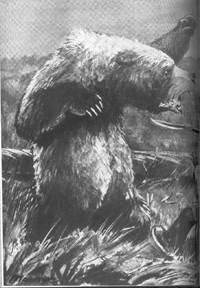St. John’s Day: Finding MacFarlane’s Bear
Posted by: Loren Coleman on June 24th, 2012
Ah, it’s June 24th again.

Photo credit: Strange Ark
Two Inuits killed a huge, yellow-furred bear at Rendezvous Lake, Barren Ground, Canada, on June 24, 1864. The bear was similar to Arctodus simus, which died out in the Pleistocene. Naturalist Robert MacFarlane acquired the bear’s skin and skull, and shipped the remains to the Smithsonian Institution, where they were placed in storage and soon forgotten. Eventually, Dr. Clinton Hart Merriam uncovered the remains, and in 1918, he described the specimen as a new species and genus, calling it the “patriarchal bear,” with the scientific name Vetularctos inopinatus. Today, it is often recognized as a new species, Ursus inopinatus. Later thoughts have called into question the uniqueness of this species. (For more, see Matt Bille’s contribution.)
On another June 24th, locals would have Bigfoot sightings, in Logan and Union counties, Ohio (1980). A Chupacabras was encountered outside a disco, at Maria Elena, Argentina (2000). Moose hunters saw a Bigfoot, near Fort Simpson, NWT, Canada (2002). A mysterious fire erupted in Mothman country, in a Gallipolis, Ohio resident’s car on a bridge from Ohio to Point Pleasant, West Virginia (2003). Massive unusual aerial phenomena (winged weirdies?) were viewed at Xalapa, Mexico (2005). “Aren’t You Chupacabra to See Me?” aired for the first time on Cartoon Network (2005). Nestle used Bigfoot-costumed marchers to launch Kit Kat Limited Edition – Cappuccino at the Giant Mahkota Parade, Malacca, and Jusco Tebrau City, Johor (2005).

For my latest look at the long list of phenomena on this special day, see Twilight Language’s new 2012 posting “St. John’s Day: June 24th.”
About Loren Coleman
Loren Coleman is one of the world’s leading cryptozoologists, some say “the” leading living cryptozoologist. Certainly, he is acknowledged as the current living American researcher and writer who has most popularized cryptozoology in the late 20th and early 21st centuries.
Starting his fieldwork and investigations in 1960, after traveling and trekking extensively in pursuit of cryptozoological mysteries, Coleman began writing to share his experiences in 1969. An honorary member of Ivan T. Sanderson’s Society for the Investigation of the Unexplained in the 1970s, Coleman has been bestowed with similar honorary memberships of the North Idaho College Cryptozoology Club in 1983, and in subsequent years, that of the British Columbia Scientific Cryptozoology Club, CryptoSafari International, and other international organizations. He was also a Life Member and Benefactor of the International Society of Cryptozoology (now-defunct).
Loren Coleman’s daily blog, as a member of the Cryptomundo Team, served as an ongoing avenue of communication for the ever-growing body of cryptozoo news from 2005 through 2013. He returned as an infrequent contributor beginning Halloween week of 2015.
Coleman is the founder in 2003, and current director of the International Cryptozoology Museum in Portland, Maine.










Pixar’s Brave was released this weekend. Though I haven’t seen it, I know a giant ‘monster bear’ is central to the story.
The only thing wrong with “St John’s Day” is the name. John the Baptist wasn’t born in June.
He was born in March.
The reason the Roman Catholic Church picked a date in June was because the Bible makes it clear that John is six months older than his cousin Jesus. And they’d already decided on the December (Yule) date for HIS birth.
Which isn’t accurate either.
If anyone wants to know how to work these dates out, visit here.
If they have the skin and skull, why not do a DNA test?